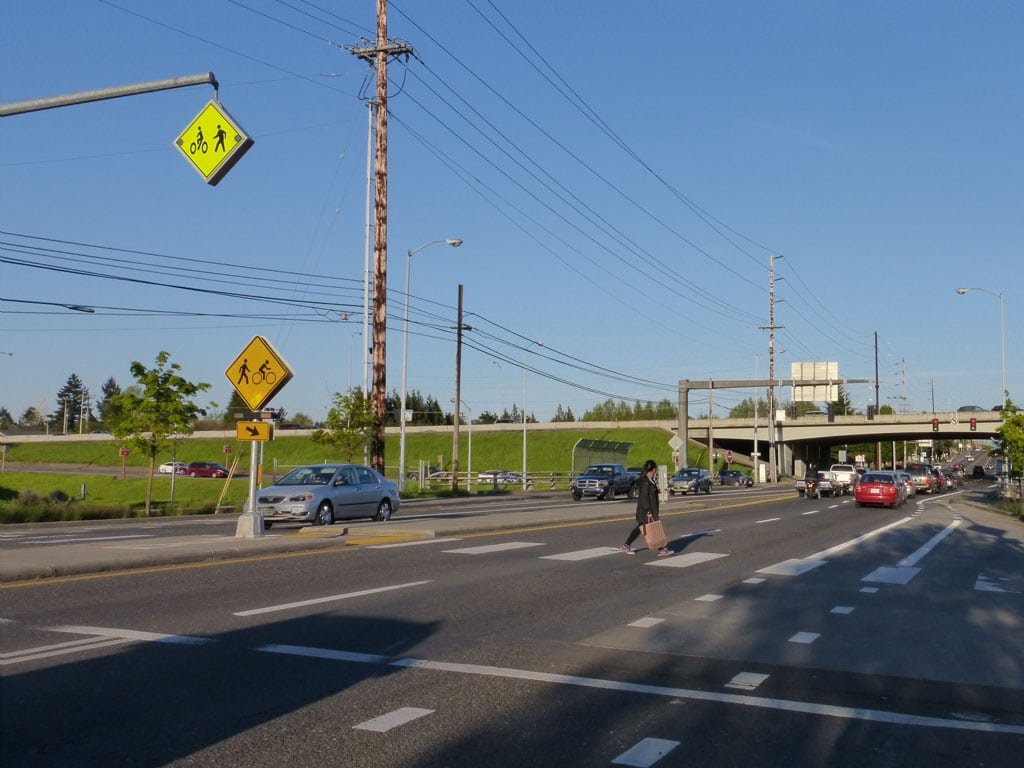Behind the wheel, we tend to become more sociopathic. Am I the only person who has heard the quip “10 points!” when you see a pedestrian infringing on your (car’s) road space? And I’m speaking as a car owner as well, so I’m not pointing any fingers.
Anyway, let us concede that the sight of a pedestrian crossing the road in front of you, when the street is designed to promote the fast movement of cars, can be an unsettling experience.
Which is why the latest fad for “rapid flash beacons” is such a depressing reminder of how far we have yet to go to promote people-friendly (and safe) places.
Table of Contents
What are rapid flash beacons?
Rapid flash beacons are a pedestrian-activated signal at a crosswalk that causes flashing lights to be activated for a period of time. These lights, attached to pedestrian signage, alert drivers that the crosswalk is being used.
More formally, from the Portland Bureau of Transportation:
A Rapid Flash Beacon catches drivers’ attention with a pair of light emitting diodes (LEDs) mounted on a pole under a pedestrian crossing sign. When the beacon is activated by a push-button system, its yellow LEDs begin flashing. Motorists are required to stop for pedestrians according to Oregon law even if the beacons are not lit. Pedestrians should make sure cars are stopped before they begin to cross the street and be aware that motorists may not obey the law or see them.
This appears to be a relatively new idea. The Federal Highway Administration page is dated 2009; there they are called “Rectangular Rapid Flash Beacons” or RRFBs (perhaps they have a range of shapes?). They are typically placed on large arterial roads that tend to act as speedways for cars, yet where pedestrians need to periodically cross in abundance.
In Portland, there are two specific places where I have experienced them:
- SW Barbur Blvd, a wooded section of road that’s more death trap than arterial. This RRFB is placed opposite a collection of apartment complexes where many buses coming from downtown stop. The less said about this one, the better.
- SE Division St, by the overpass of I-205 and the MAX Green Line. People are typically connecting to and from the bus stop on Division and the MAX stop across the way.
A cynical sign
From a desk at the DOT, RRFBs seem like a good idea. These streets are “important” arterials, so the goal is to move cars, but yet, pedestrians need to cross this street at odd intervals. So an RRFB seems like an inexpensive way to accomplish all of these goals.
But to me, the use of RRFBs feels deeply cynical, to say nothing about being possibly ineffectual and dangerous:
- The lights are not always so visible in broad daylight. It’s easy to miss them if you’re going fast or if there’s a lot of traffic to contend with.
- The flashing lights are mostly on the side of the road, where approximately 0% of drivers are likely to look.
- These signs are unexpected. Everyone knows what an intersection with a streetlight looks like, but it’s unclear what the heck this ever is when you first come upon it.
- The blinking lights are yellow. Say what you will about what the yellow light is supposed to mean, but you and I all know that in practical matters yellow means “optional”. Or, perhaps “go very fast”:[youtube]https://www.youtube.com/watch?v=6NEFYCaKakE[/youtube]Nowhere else is this more obvious than with the voice that sounds from the box as the person crosses. “Cross street with caution. Vehicles may not stop.” Which is kind of like saying “we don’t expect drivers to pay attention to this sign, but at least our conscience is clear.“
Blink or you’ll miss it
Let’s take that example on SE Division. This is the scene you as driver are confronted with as you approach:

Notice that there is no sign above the road where you would normally look. There is only a sign above the median and on the right curb. Instead, what do you notice? The other traffic light a block away! It’s like they’ve designed this for maximal distraction.

Personally, I don’t think any sexy new technologies need to be put in place here. How about a standard traffic light? The person who wants to cross the road could activate the signal, and then cross once the light switched over. After a short period of time, the light would switch back. It could actually have the effect of prioritizing pedestrians, but in a way that encourages drivers to actually pay attention.
Or failing that, how about just making the lights red instead of yellow? Which color do you think would be more effective?
Good being the enemy of the terrible
I will give the use of RRFBs some legitimate credit, in that they at least are light-years beyond the idea that we would need to restrict pedestrians from crossing the street at all. As an example, a few blocks down along the same road, you see just this:

This overpass says to the would-be user: “rather than inconvenience drivers in any way, which costs no penalty to them at all aside from a few seconds of wait time, we’ll just inconvenience you.”

So, when compared to this situation, RRFBs are certainly an improvement. But I still think we can—and must—do better.
Do you have rapid flash beacons in your area? How would you make it easier to cross the road?

